Analyzing Commonwealth Bank's Strategy to Enter Indian Market
VerifiedAdded on 2020/03/02
|10
|2122
|72
Report
AI Summary
This report provides a detailed analysis of the Commonwealth Bank's (CBA) strategy to enter the Indian market. It begins with an introduction to the bank and its international operations, followed by a situation analysis that examines the political, economic, social, technological, legal, and environmental factors influencing the Indian business environment. The report then delves into a market analysis of the Indian banking sector, including its structure, competitive landscape, and the impact of technology. An organizational analysis of CBA and a SWOT analysis are also presented, highlighting the bank's strengths, weaknesses, opportunities, and threats. The report concludes with recommendations for CBA's market entry strategy, considering the challenges and opportunities in the Indian market, and referencing relevant academic sources. The report highlights the competitive landscape, including the presence of international and local banks, and addresses the impact of technological advancements in the banking sector. Finally, the report considers the challenges faced by foreign banks in India.
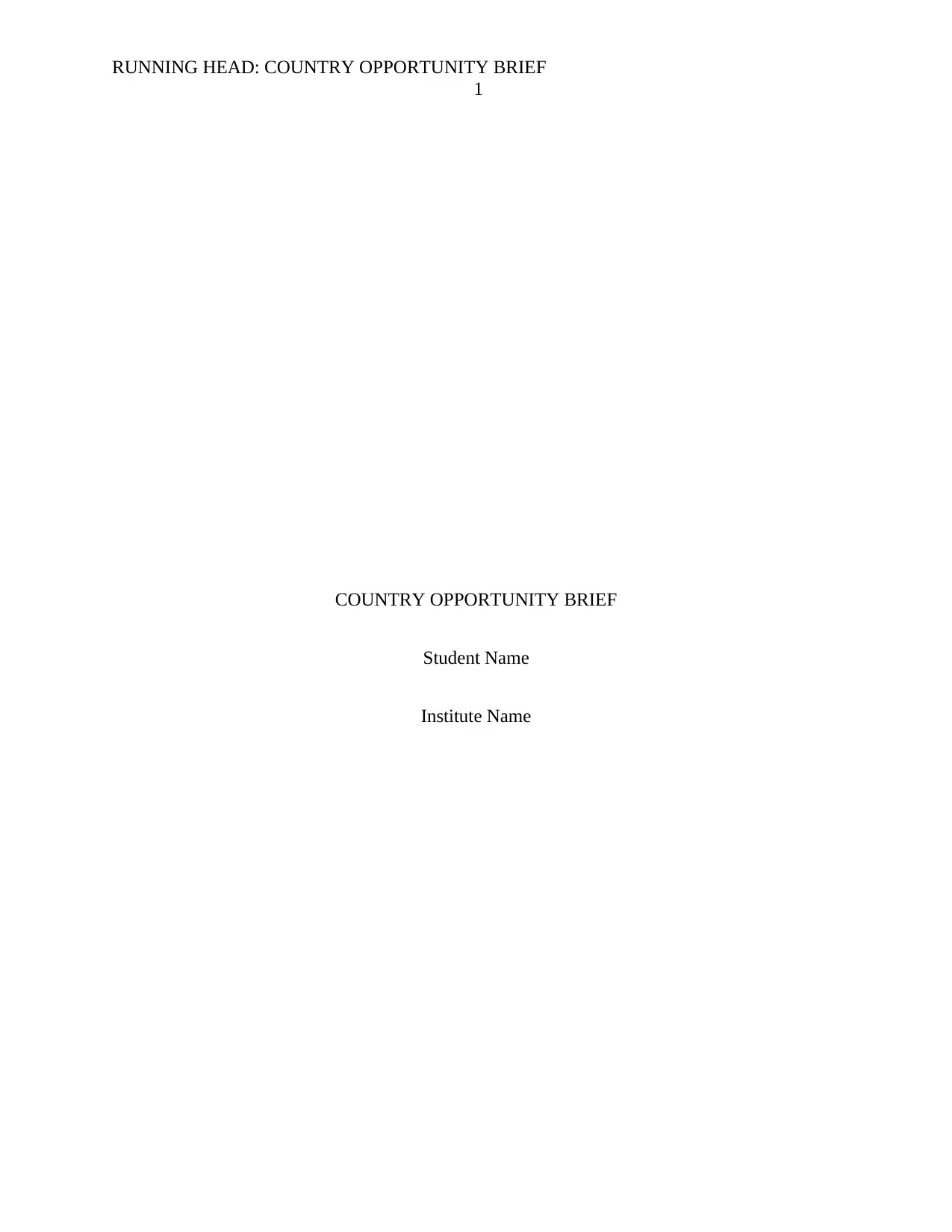
RUNNING HEAD: COUNTRY OPPORTUNITY BRIEF
1
COUNTRY OPPORTUNITY BRIEF
Student Name
Institute Name
1
COUNTRY OPPORTUNITY BRIEF
Student Name
Institute Name
Paraphrase This Document
Need a fresh take? Get an instant paraphrase of this document with our AI Paraphraser
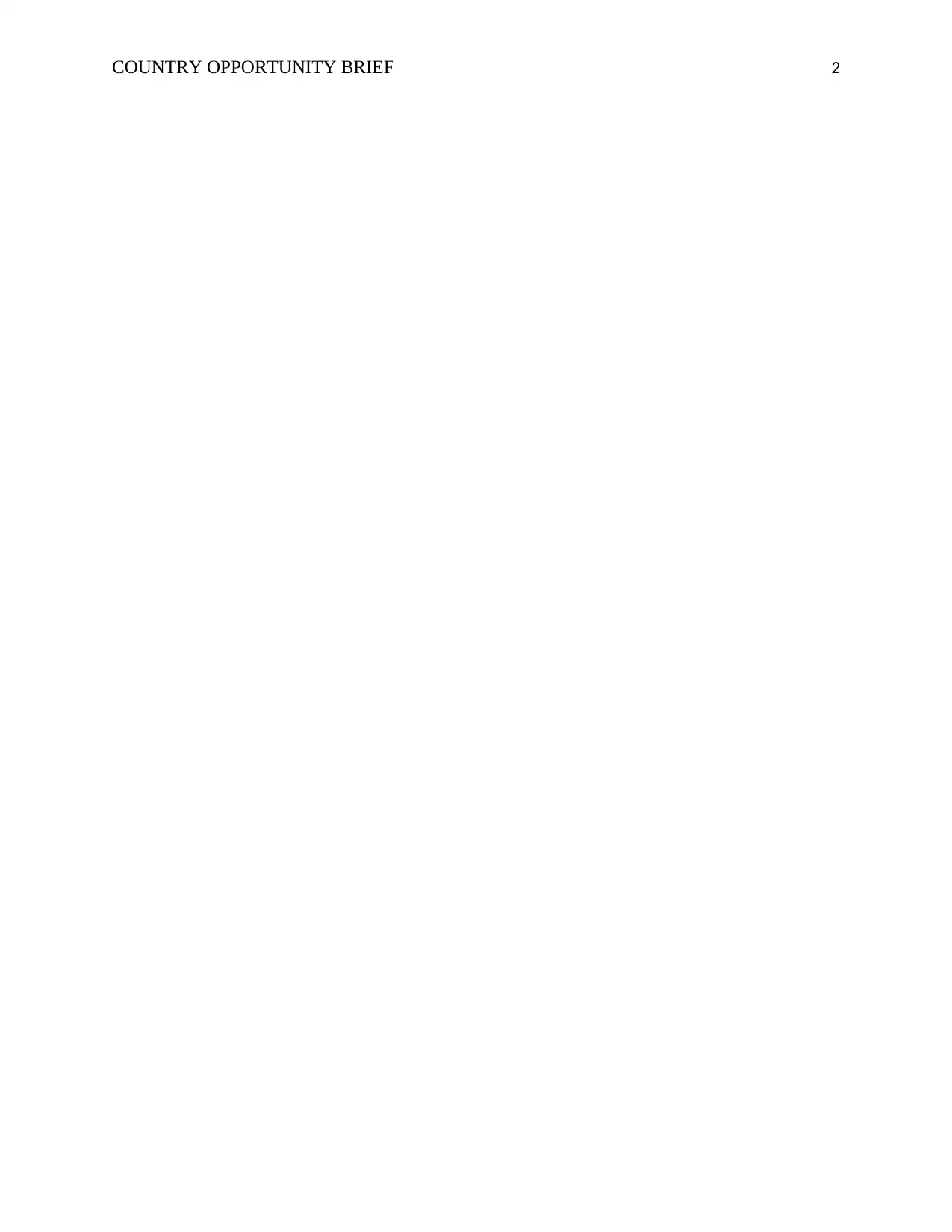
COUNTRY OPPORTUNITY BRIEF 2
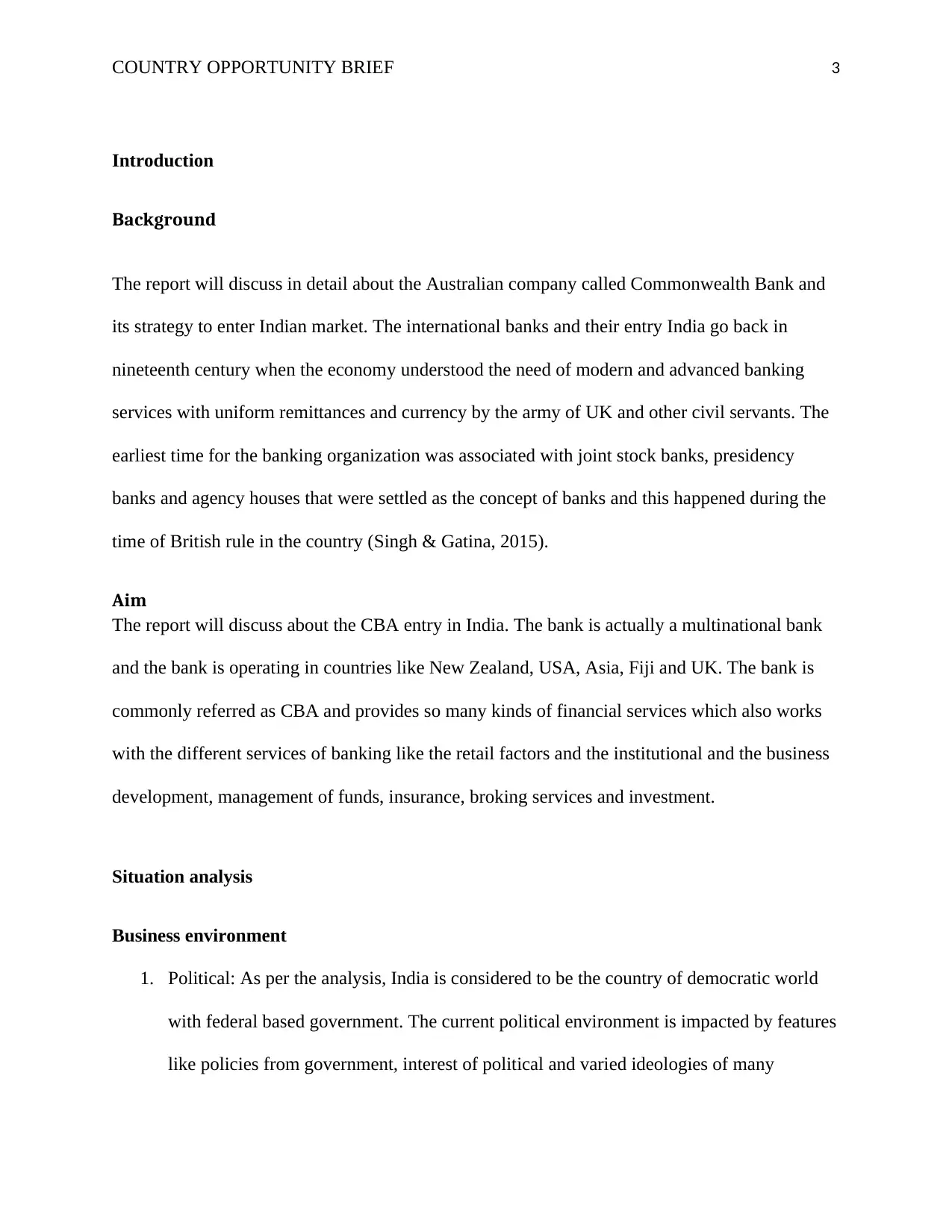
COUNTRY OPPORTUNITY BRIEF 3
Introduction
Background
The report will discuss in detail about the Australian company called Commonwealth Bank and
its strategy to enter Indian market. The international banks and their entry India go back in
nineteenth century when the economy understood the need of modern and advanced banking
services with uniform remittances and currency by the army of UK and other civil servants. The
earliest time for the banking organization was associated with joint stock banks, presidency
banks and agency houses that were settled as the concept of banks and this happened during the
time of British rule in the country (Singh & Gatina, 2015).
Aim
The report will discuss about the CBA entry in India. The bank is actually a multinational bank
and the bank is operating in countries like New Zealand, USA, Asia, Fiji and UK. The bank is
commonly referred as CBA and provides so many kinds of financial services which also works
with the different services of banking like the retail factors and the institutional and the business
development, management of funds, insurance, broking services and investment.
Situation analysis
Business environment
1. Political: As per the analysis, India is considered to be the country of democratic world
with federal based government. The current political environment is impacted by features
like policies from government, interest of political and varied ideologies of many
Introduction
Background
The report will discuss in detail about the Australian company called Commonwealth Bank and
its strategy to enter Indian market. The international banks and their entry India go back in
nineteenth century when the economy understood the need of modern and advanced banking
services with uniform remittances and currency by the army of UK and other civil servants. The
earliest time for the banking organization was associated with joint stock banks, presidency
banks and agency houses that were settled as the concept of banks and this happened during the
time of British rule in the country (Singh & Gatina, 2015).
Aim
The report will discuss about the CBA entry in India. The bank is actually a multinational bank
and the bank is operating in countries like New Zealand, USA, Asia, Fiji and UK. The bank is
commonly referred as CBA and provides so many kinds of financial services which also works
with the different services of banking like the retail factors and the institutional and the business
development, management of funds, insurance, broking services and investment.
Situation analysis
Business environment
1. Political: As per the analysis, India is considered to be the country of democratic world
with federal based government. The current political environment is impacted by features
like policies from government, interest of political and varied ideologies of many
⊘ This is a preview!⊘
Do you want full access?
Subscribe today to unlock all pages.

Trusted by 1+ million students worldwide
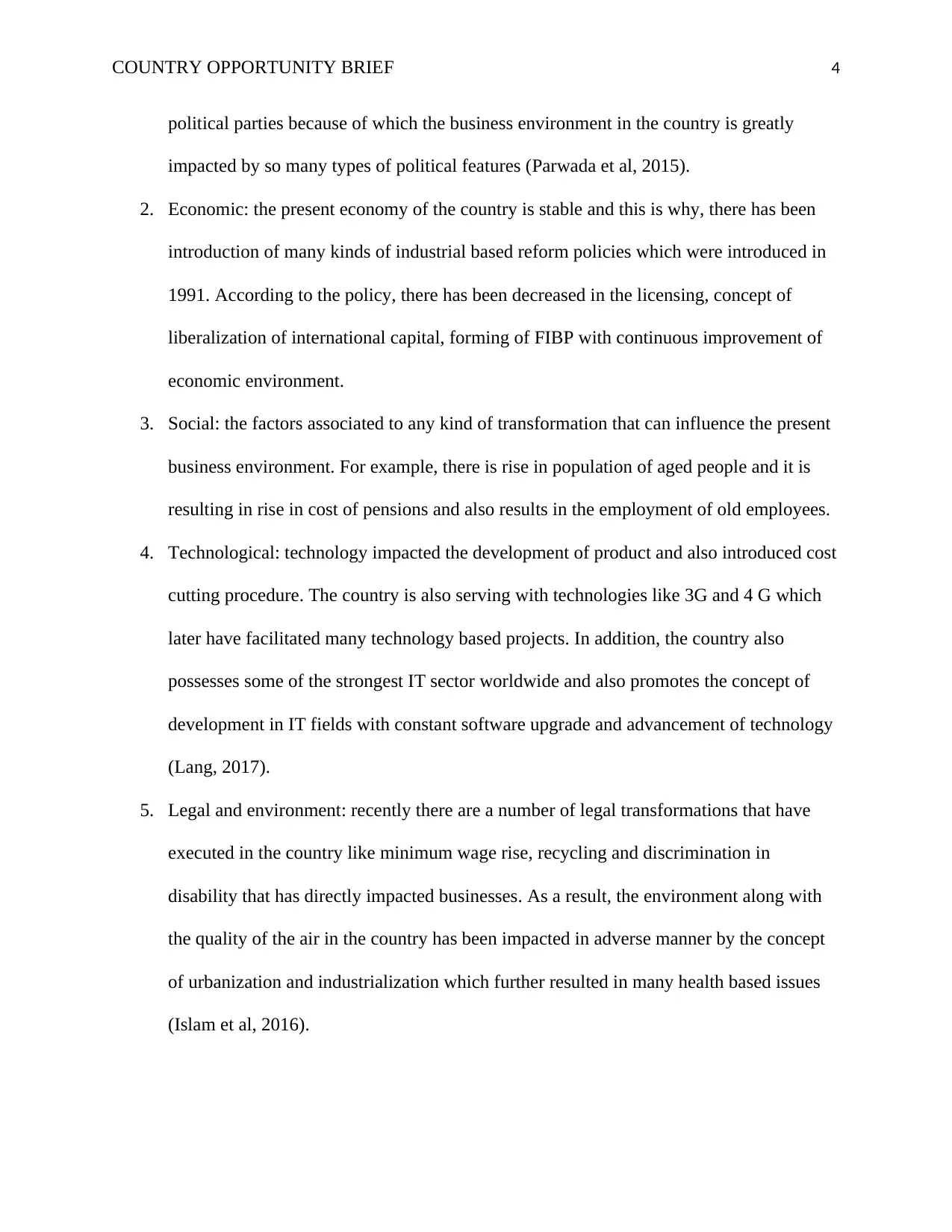
COUNTRY OPPORTUNITY BRIEF 4
political parties because of which the business environment in the country is greatly
impacted by so many types of political features (Parwada et al, 2015).
2. Economic: the present economy of the country is stable and this is why, there has been
introduction of many kinds of industrial based reform policies which were introduced in
1991. According to the policy, there has been decreased in the licensing, concept of
liberalization of international capital, forming of FIBP with continuous improvement of
economic environment.
3. Social: the factors associated to any kind of transformation that can influence the present
business environment. For example, there is rise in population of aged people and it is
resulting in rise in cost of pensions and also results in the employment of old employees.
4. Technological: technology impacted the development of product and also introduced cost
cutting procedure. The country is also serving with technologies like 3G and 4 G which
later have facilitated many technology based projects. In addition, the country also
possesses some of the strongest IT sector worldwide and also promotes the concept of
development in IT fields with constant software upgrade and advancement of technology
(Lang, 2017).
5. Legal and environment: recently there are a number of legal transformations that have
executed in the country like minimum wage rise, recycling and discrimination in
disability that has directly impacted businesses. As a result, the environment along with
the quality of the air in the country has been impacted in adverse manner by the concept
of urbanization and industrialization which further resulted in many health based issues
(Islam et al, 2016).
political parties because of which the business environment in the country is greatly
impacted by so many types of political features (Parwada et al, 2015).
2. Economic: the present economy of the country is stable and this is why, there has been
introduction of many kinds of industrial based reform policies which were introduced in
1991. According to the policy, there has been decreased in the licensing, concept of
liberalization of international capital, forming of FIBP with continuous improvement of
economic environment.
3. Social: the factors associated to any kind of transformation that can influence the present
business environment. For example, there is rise in population of aged people and it is
resulting in rise in cost of pensions and also results in the employment of old employees.
4. Technological: technology impacted the development of product and also introduced cost
cutting procedure. The country is also serving with technologies like 3G and 4 G which
later have facilitated many technology based projects. In addition, the country also
possesses some of the strongest IT sector worldwide and also promotes the concept of
development in IT fields with constant software upgrade and advancement of technology
(Lang, 2017).
5. Legal and environment: recently there are a number of legal transformations that have
executed in the country like minimum wage rise, recycling and discrimination in
disability that has directly impacted businesses. As a result, the environment along with
the quality of the air in the country has been impacted in adverse manner by the concept
of urbanization and industrialization which further resulted in many health based issues
(Islam et al, 2016).
Paraphrase This Document
Need a fresh take? Get an instant paraphrase of this document with our AI Paraphraser
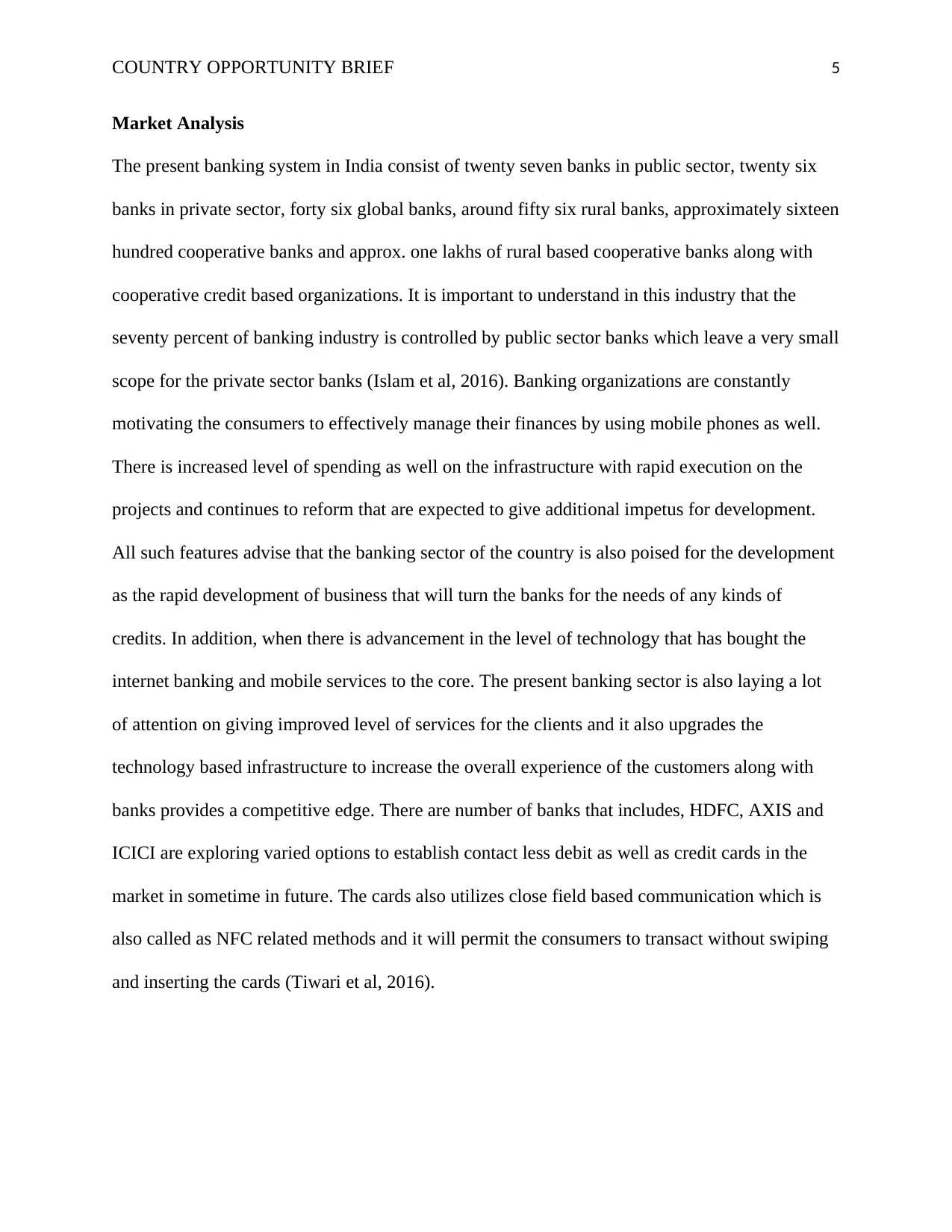
COUNTRY OPPORTUNITY BRIEF 5
Market Analysis
The present banking system in India consist of twenty seven banks in public sector, twenty six
banks in private sector, forty six global banks, around fifty six rural banks, approximately sixteen
hundred cooperative banks and approx. one lakhs of rural based cooperative banks along with
cooperative credit based organizations. It is important to understand in this industry that the
seventy percent of banking industry is controlled by public sector banks which leave a very small
scope for the private sector banks (Islam et al, 2016). Banking organizations are constantly
motivating the consumers to effectively manage their finances by using mobile phones as well.
There is increased level of spending as well on the infrastructure with rapid execution on the
projects and continues to reform that are expected to give additional impetus for development.
All such features advise that the banking sector of the country is also poised for the development
as the rapid development of business that will turn the banks for the needs of any kinds of
credits. In addition, when there is advancement in the level of technology that has bought the
internet banking and mobile services to the core. The present banking sector is also laying a lot
of attention on giving improved level of services for the clients and it also upgrades the
technology based infrastructure to increase the overall experience of the customers along with
banks provides a competitive edge. There are number of banks that includes, HDFC, AXIS and
ICICI are exploring varied options to establish contact less debit as well as credit cards in the
market in sometime in future. The cards also utilizes close field based communication which is
also called as NFC related methods and it will permit the consumers to transact without swiping
and inserting the cards (Tiwari et al, 2016).
Market Analysis
The present banking system in India consist of twenty seven banks in public sector, twenty six
banks in private sector, forty six global banks, around fifty six rural banks, approximately sixteen
hundred cooperative banks and approx. one lakhs of rural based cooperative banks along with
cooperative credit based organizations. It is important to understand in this industry that the
seventy percent of banking industry is controlled by public sector banks which leave a very small
scope for the private sector banks (Islam et al, 2016). Banking organizations are constantly
motivating the consumers to effectively manage their finances by using mobile phones as well.
There is increased level of spending as well on the infrastructure with rapid execution on the
projects and continues to reform that are expected to give additional impetus for development.
All such features advise that the banking sector of the country is also poised for the development
as the rapid development of business that will turn the banks for the needs of any kinds of
credits. In addition, when there is advancement in the level of technology that has bought the
internet banking and mobile services to the core. The present banking sector is also laying a lot
of attention on giving improved level of services for the clients and it also upgrades the
technology based infrastructure to increase the overall experience of the customers along with
banks provides a competitive edge. There are number of banks that includes, HDFC, AXIS and
ICICI are exploring varied options to establish contact less debit as well as credit cards in the
market in sometime in future. The cards also utilizes close field based communication which is
also called as NFC related methods and it will permit the consumers to transact without swiping
and inserting the cards (Tiwari et al, 2016).
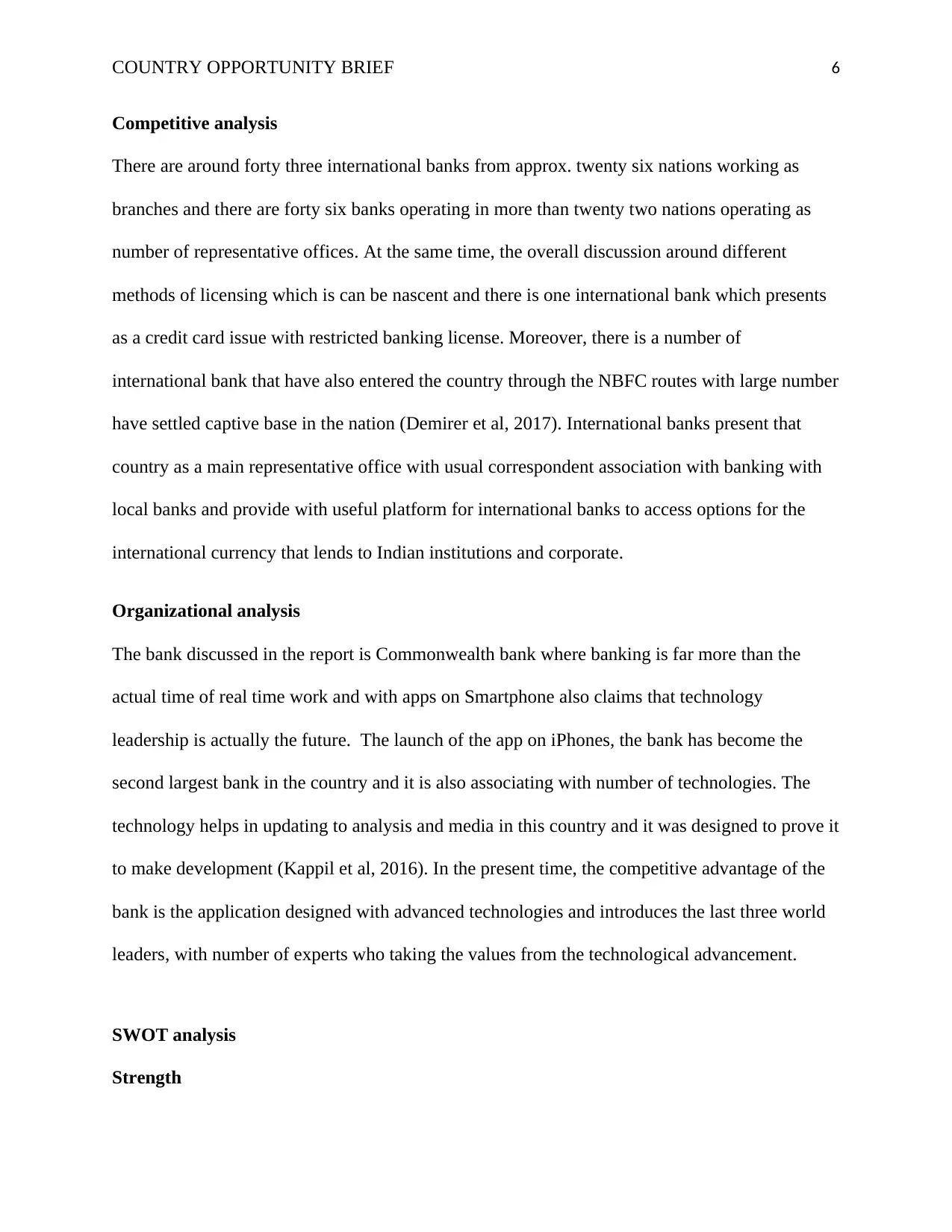
COUNTRY OPPORTUNITY BRIEF 6
Competitive analysis
There are around forty three international banks from approx. twenty six nations working as
branches and there are forty six banks operating in more than twenty two nations operating as
number of representative offices. At the same time, the overall discussion around different
methods of licensing which is can be nascent and there is one international bank which presents
as a credit card issue with restricted banking license. Moreover, there is a number of
international bank that have also entered the country through the NBFC routes with large number
have settled captive base in the nation (Demirer et al, 2017). International banks present that
country as a main representative office with usual correspondent association with banking with
local banks and provide with useful platform for international banks to access options for the
international currency that lends to Indian institutions and corporate.
Organizational analysis
The bank discussed in the report is Commonwealth bank where banking is far more than the
actual time of real time work and with apps on Smartphone also claims that technology
leadership is actually the future. The launch of the app on iPhones, the bank has become the
second largest bank in the country and it is also associating with number of technologies. The
technology helps in updating to analysis and media in this country and it was designed to prove it
to make development (Kappil et al, 2016). In the present time, the competitive advantage of the
bank is the application designed with advanced technologies and introduces the last three world
leaders, with number of experts who taking the values from the technological advancement.
SWOT analysis
Strength
Competitive analysis
There are around forty three international banks from approx. twenty six nations working as
branches and there are forty six banks operating in more than twenty two nations operating as
number of representative offices. At the same time, the overall discussion around different
methods of licensing which is can be nascent and there is one international bank which presents
as a credit card issue with restricted banking license. Moreover, there is a number of
international bank that have also entered the country through the NBFC routes with large number
have settled captive base in the nation (Demirer et al, 2017). International banks present that
country as a main representative office with usual correspondent association with banking with
local banks and provide with useful platform for international banks to access options for the
international currency that lends to Indian institutions and corporate.
Organizational analysis
The bank discussed in the report is Commonwealth bank where banking is far more than the
actual time of real time work and with apps on Smartphone also claims that technology
leadership is actually the future. The launch of the app on iPhones, the bank has become the
second largest bank in the country and it is also associating with number of technologies. The
technology helps in updating to analysis and media in this country and it was designed to prove it
to make development (Kappil et al, 2016). In the present time, the competitive advantage of the
bank is the application designed with advanced technologies and introduces the last three world
leaders, with number of experts who taking the values from the technological advancement.
SWOT analysis
Strength
⊘ This is a preview!⊘
Do you want full access?
Subscribe today to unlock all pages.

Trusted by 1+ million students worldwide
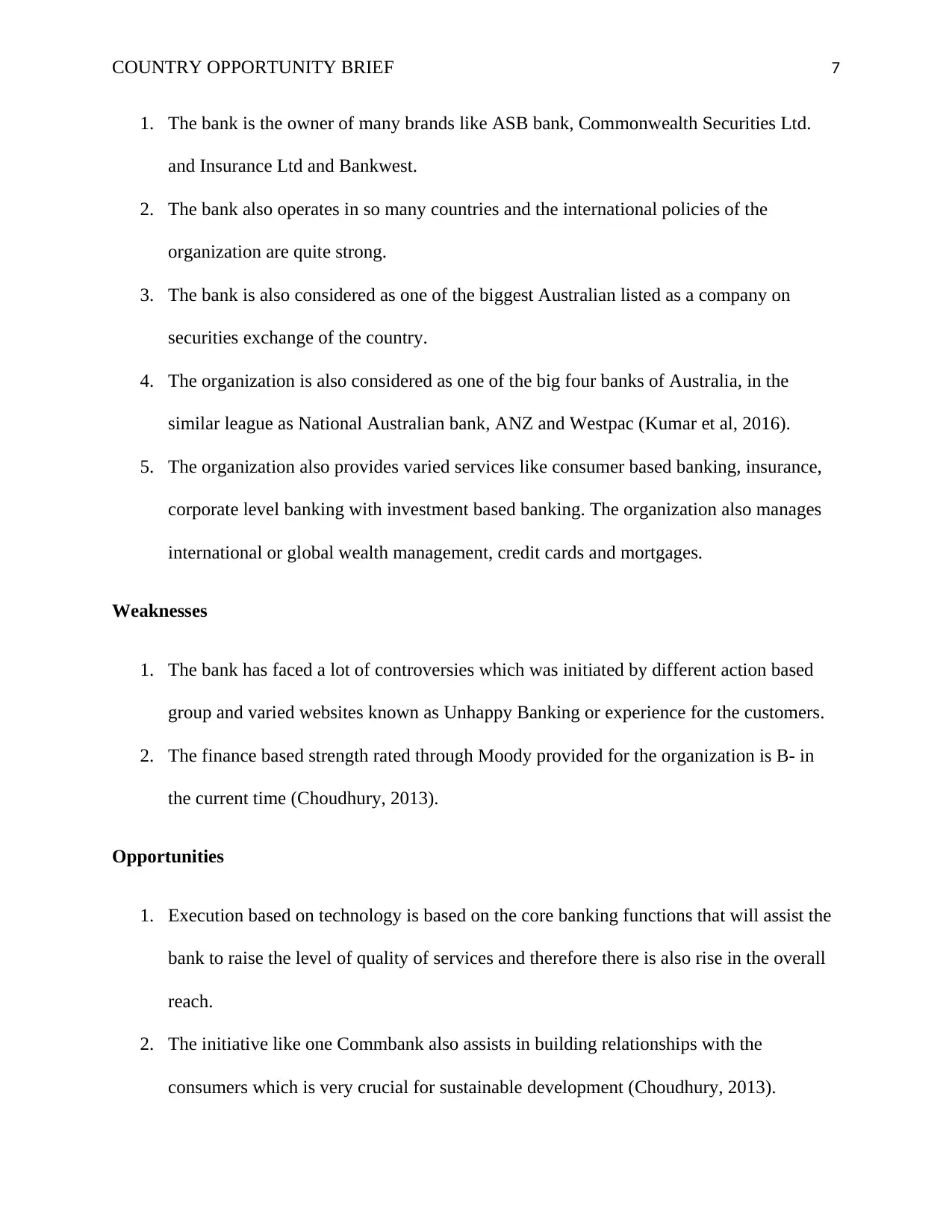
COUNTRY OPPORTUNITY BRIEF 7
1. The bank is the owner of many brands like ASB bank, Commonwealth Securities Ltd.
and Insurance Ltd and Bankwest.
2. The bank also operates in so many countries and the international policies of the
organization are quite strong.
3. The bank is also considered as one of the biggest Australian listed as a company on
securities exchange of the country.
4. The organization is also considered as one of the big four banks of Australia, in the
similar league as National Australian bank, ANZ and Westpac (Kumar et al, 2016).
5. The organization also provides varied services like consumer based banking, insurance,
corporate level banking with investment based banking. The organization also manages
international or global wealth management, credit cards and mortgages.
Weaknesses
1. The bank has faced a lot of controversies which was initiated by different action based
group and varied websites known as Unhappy Banking or experience for the customers.
2. The finance based strength rated through Moody provided for the organization is B- in
the current time (Choudhury, 2013).
Opportunities
1. Execution based on technology is based on the core banking functions that will assist the
bank to raise the level of quality of services and therefore there is also rise in the overall
reach.
2. The initiative like one Commbank also assists in building relationships with the
consumers which is very crucial for sustainable development (Choudhury, 2013).
1. The bank is the owner of many brands like ASB bank, Commonwealth Securities Ltd.
and Insurance Ltd and Bankwest.
2. The bank also operates in so many countries and the international policies of the
organization are quite strong.
3. The bank is also considered as one of the biggest Australian listed as a company on
securities exchange of the country.
4. The organization is also considered as one of the big four banks of Australia, in the
similar league as National Australian bank, ANZ and Westpac (Kumar et al, 2016).
5. The organization also provides varied services like consumer based banking, insurance,
corporate level banking with investment based banking. The organization also manages
international or global wealth management, credit cards and mortgages.
Weaknesses
1. The bank has faced a lot of controversies which was initiated by different action based
group and varied websites known as Unhappy Banking or experience for the customers.
2. The finance based strength rated through Moody provided for the organization is B- in
the current time (Choudhury, 2013).
Opportunities
1. Execution based on technology is based on the core banking functions that will assist the
bank to raise the level of quality of services and therefore there is also rise in the overall
reach.
2. The initiative like one Commbank also assists in building relationships with the
consumers which is very crucial for sustainable development (Choudhury, 2013).
Paraphrase This Document
Need a fresh take? Get an instant paraphrase of this document with our AI Paraphraser
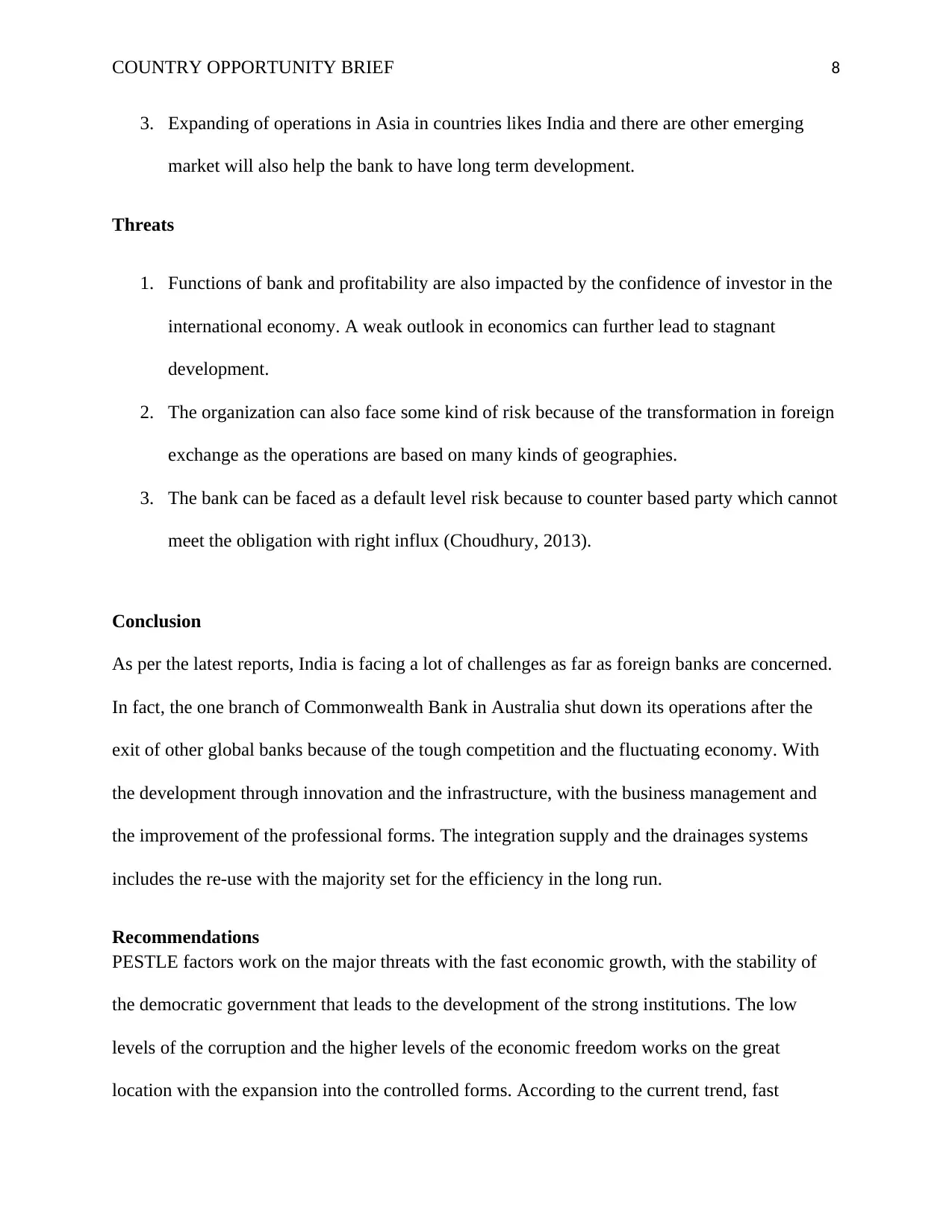
COUNTRY OPPORTUNITY BRIEF 8
3. Expanding of operations in Asia in countries likes India and there are other emerging
market will also help the bank to have long term development.
Threats
1. Functions of bank and profitability are also impacted by the confidence of investor in the
international economy. A weak outlook in economics can further lead to stagnant
development.
2. The organization can also face some kind of risk because of the transformation in foreign
exchange as the operations are based on many kinds of geographies.
3. The bank can be faced as a default level risk because to counter based party which cannot
meet the obligation with right influx (Choudhury, 2013).
Conclusion
As per the latest reports, India is facing a lot of challenges as far as foreign banks are concerned.
In fact, the one branch of Commonwealth Bank in Australia shut down its operations after the
exit of other global banks because of the tough competition and the fluctuating economy. With
the development through innovation and the infrastructure, with the business management and
the improvement of the professional forms. The integration supply and the drainages systems
includes the re-use with the majority set for the efficiency in the long run.
Recommendations
PESTLE factors work on the major threats with the fast economic growth, with the stability of
the democratic government that leads to the development of the strong institutions. The low
levels of the corruption and the higher levels of the economic freedom works on the great
location with the expansion into the controlled forms. According to the current trend, fast
3. Expanding of operations in Asia in countries likes India and there are other emerging
market will also help the bank to have long term development.
Threats
1. Functions of bank and profitability are also impacted by the confidence of investor in the
international economy. A weak outlook in economics can further lead to stagnant
development.
2. The organization can also face some kind of risk because of the transformation in foreign
exchange as the operations are based on many kinds of geographies.
3. The bank can be faced as a default level risk because to counter based party which cannot
meet the obligation with right influx (Choudhury, 2013).
Conclusion
As per the latest reports, India is facing a lot of challenges as far as foreign banks are concerned.
In fact, the one branch of Commonwealth Bank in Australia shut down its operations after the
exit of other global banks because of the tough competition and the fluctuating economy. With
the development through innovation and the infrastructure, with the business management and
the improvement of the professional forms. The integration supply and the drainages systems
includes the re-use with the majority set for the efficiency in the long run.
Recommendations
PESTLE factors work on the major threats with the fast economic growth, with the stability of
the democratic government that leads to the development of the strong institutions. The low
levels of the corruption and the higher levels of the economic freedom works on the great
location with the expansion into the controlled forms. According to the current trend, fast
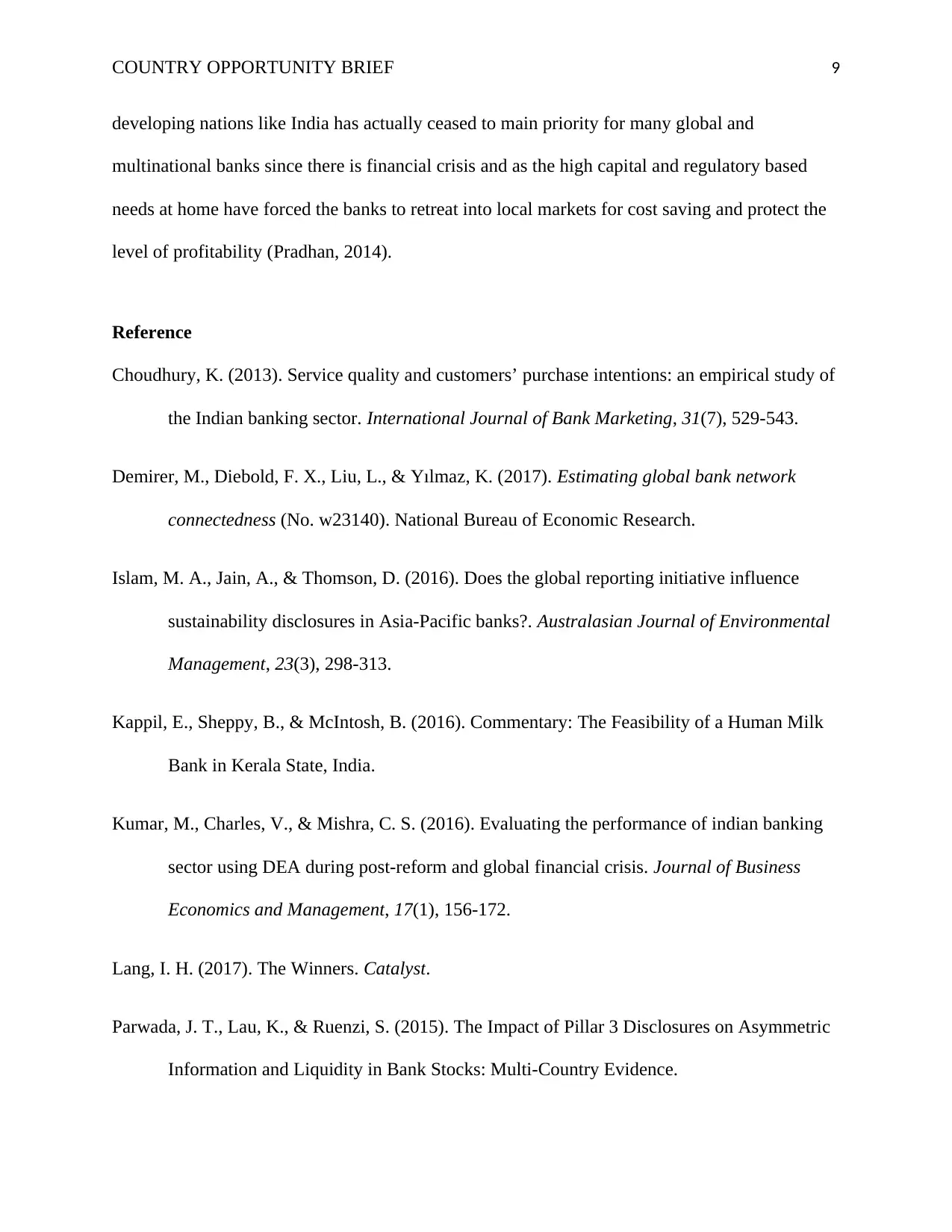
COUNTRY OPPORTUNITY BRIEF 9
developing nations like India has actually ceased to main priority for many global and
multinational banks since there is financial crisis and as the high capital and regulatory based
needs at home have forced the banks to retreat into local markets for cost saving and protect the
level of profitability (Pradhan, 2014).
Reference
Choudhury, K. (2013). Service quality and customers’ purchase intentions: an empirical study of
the Indian banking sector. International Journal of Bank Marketing, 31(7), 529-543.
Demirer, M., Diebold, F. X., Liu, L., & Yılmaz, K. (2017). Estimating global bank network
connectedness (No. w23140). National Bureau of Economic Research.
Islam, M. A., Jain, A., & Thomson, D. (2016). Does the global reporting initiative influence
sustainability disclosures in Asia-Pacific banks?. Australasian Journal of Environmental
Management, 23(3), 298-313.
Kappil, E., Sheppy, B., & McIntosh, B. (2016). Commentary: The Feasibility of a Human Milk
Bank in Kerala State, India.
Kumar, M., Charles, V., & Mishra, C. S. (2016). Evaluating the performance of indian banking
sector using DEA during post-reform and global financial crisis. Journal of Business
Economics and Management, 17(1), 156-172.
Lang, I. H. (2017). The Winners. Catalyst.
Parwada, J. T., Lau, K., & Ruenzi, S. (2015). The Impact of Pillar 3 Disclosures on Asymmetric
Information and Liquidity in Bank Stocks: Multi-Country Evidence.
developing nations like India has actually ceased to main priority for many global and
multinational banks since there is financial crisis and as the high capital and regulatory based
needs at home have forced the banks to retreat into local markets for cost saving and protect the
level of profitability (Pradhan, 2014).
Reference
Choudhury, K. (2013). Service quality and customers’ purchase intentions: an empirical study of
the Indian banking sector. International Journal of Bank Marketing, 31(7), 529-543.
Demirer, M., Diebold, F. X., Liu, L., & Yılmaz, K. (2017). Estimating global bank network
connectedness (No. w23140). National Bureau of Economic Research.
Islam, M. A., Jain, A., & Thomson, D. (2016). Does the global reporting initiative influence
sustainability disclosures in Asia-Pacific banks?. Australasian Journal of Environmental
Management, 23(3), 298-313.
Kappil, E., Sheppy, B., & McIntosh, B. (2016). Commentary: The Feasibility of a Human Milk
Bank in Kerala State, India.
Kumar, M., Charles, V., & Mishra, C. S. (2016). Evaluating the performance of indian banking
sector using DEA during post-reform and global financial crisis. Journal of Business
Economics and Management, 17(1), 156-172.
Lang, I. H. (2017). The Winners. Catalyst.
Parwada, J. T., Lau, K., & Ruenzi, S. (2015). The Impact of Pillar 3 Disclosures on Asymmetric
Information and Liquidity in Bank Stocks: Multi-Country Evidence.
⊘ This is a preview!⊘
Do you want full access?
Subscribe today to unlock all pages.

Trusted by 1+ million students worldwide
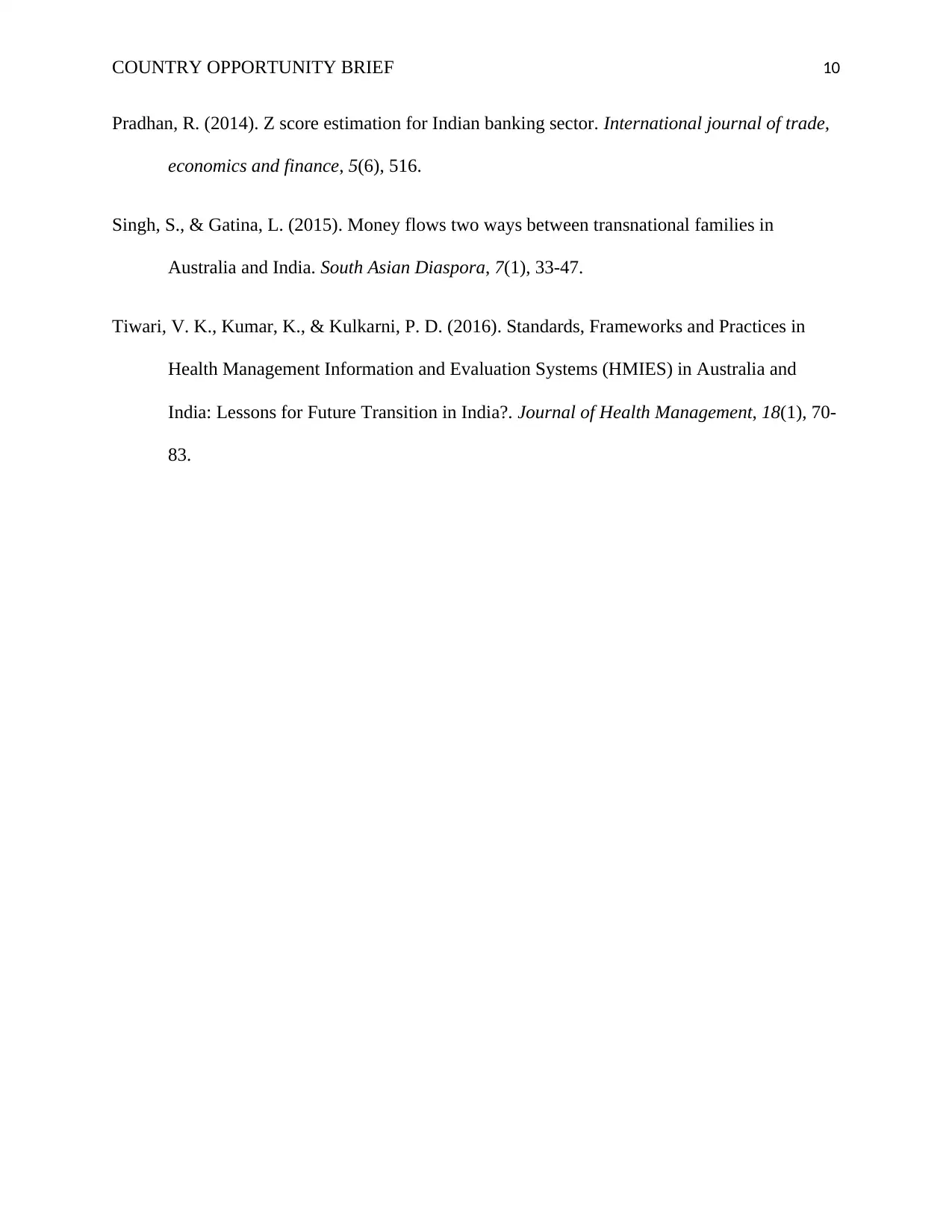
COUNTRY OPPORTUNITY BRIEF 10
Pradhan, R. (2014). Z score estimation for Indian banking sector. International journal of trade,
economics and finance, 5(6), 516.
Singh, S., & Gatina, L. (2015). Money flows two ways between transnational families in
Australia and India. South Asian Diaspora, 7(1), 33-47.
Tiwari, V. K., Kumar, K., & Kulkarni, P. D. (2016). Standards, Frameworks and Practices in
Health Management Information and Evaluation Systems (HMIES) in Australia and
India: Lessons for Future Transition in India?. Journal of Health Management, 18(1), 70-
83.
Pradhan, R. (2014). Z score estimation for Indian banking sector. International journal of trade,
economics and finance, 5(6), 516.
Singh, S., & Gatina, L. (2015). Money flows two ways between transnational families in
Australia and India. South Asian Diaspora, 7(1), 33-47.
Tiwari, V. K., Kumar, K., & Kulkarni, P. D. (2016). Standards, Frameworks and Practices in
Health Management Information and Evaluation Systems (HMIES) in Australia and
India: Lessons for Future Transition in India?. Journal of Health Management, 18(1), 70-
83.
1 out of 10
Related Documents
Your All-in-One AI-Powered Toolkit for Academic Success.
+13062052269
info@desklib.com
Available 24*7 on WhatsApp / Email
![[object Object]](/_next/static/media/star-bottom.7253800d.svg)
Unlock your academic potential
Copyright © 2020–2025 A2Z Services. All Rights Reserved. Developed and managed by ZUCOL.





